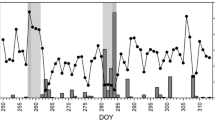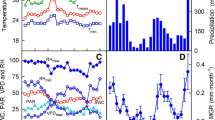Abstract
In water-limited systems, pulses of rainfall can trigger a cascade of plant physiological responses. However, the timing and size of the physiological response can vary depending on plant and environmental characteristics, such as rooting depth, plant size, rainfall amount, or antecedent soil moisture. We investigated the influence of pulses of rainfall on the response of sap flow of two dominant evergreen tree species, Eucalyptus crebra (a broadleaf) and Callitris glaucophylla (a needle leaved tree), in a remnant open woodland in eastern Australia. Sap flow data were collected using heat-pulse sensors installed in six trees of each species over a 2 year period which encompassed the tail-end of a widespread drought. Our objectives were to estimate the magnitude that a rainfall pulse had to exceed to increase tree water use (i.e., define the threshold response), and to determine how tree and environmental factors influenced the increase in tree water use following a rainfall pulse. We used data filtering techniques to isolate rainfall pulses, and analysed the resulting data with multivariate statistical analysis. We found that rainfall pulses less than 20 mm did not significantly increase tree water use (P > 0.05). Using partial regression analysis to hold all other variables constant, we determined that the size of the rain event (P < 0.05, R 2 = 0.59), antecedent soil moisture (P < 0.05, R 2 = 0.29), and tree size (DBH, cm, P < 0.05, R 2 = 0.15), all significantly affected the response to rainfall. Our results suggest that the conceptual Threshold-Delay model describing physiological responses to rainfall pulses could be modified to include these factors. We further conclude that modelling of stand water use over an annual cycle could be improved by incorporating the T-D behaviour of tree transpiration.






Similar content being viewed by others
References
Banks R (1998) Soil landscapes of the Blackville 1:100 000 Sheet. Department of Land and Water Conservation, Gunnedah
BassiriRad H, Tremmel DC, Virginia RA, Reynolds JF, de Soyza AG, Brunell MH (1999) Short-term patterns in water and nitrogen acquisition by two desert shrubs following a simulated summer rain. Plant Ecol 145:27–36
Burgess SSO (2006) Measuring transpiration responses to summer precipitation in a Mediterranean climate: a simple screening tool for identifying plant water-use strategies. Physiol Plant 127:404–412
Cheng X, An S, Li B, Chen J, Lin G, Liu Y, Luo Y, Liu S (2006) Summer rain pulse size and rainwater uptake by three dominant desert plants in a desertified grassland ecosystem in northwestern China. Plant Ecol 184:1–12
Chesson P, Gebauer RLE, Schwinning S, Huntly N, Wiegand K, Ernest MSK, Sher A, Novoplansky A, Weltzin JF (2004) Resource pulses, species interactions, and diversity maintenance in arid and semi-arid environments. Oecologia 141:236–253
Crane M, Newman MC (2000) What level of effect is a no observed effect? Environ Toxicol Chem 19:516–519
Crockford RH, Richardson DP (2000) Partitioning of rainfall into throughfall, stemflow and interception: effect of forest type, ground cover and climate. Hydro Proc 14:2903–2920
Eamus D, Hatton TJ, Cook PG, Colvin C (2006) Ecohydrology: vegetation function, water and resource management. CSIRO, Melbourne, 348 pp
Eberbach PL, Burrows GE (2006) The transpiration response by four topographically distributed Eucalyptus species, to rainfall occurring during drought in south eastern Australia. Physiol Plant 127:483–493
Fravolini A, Hultine KR, Brugnoli E, Gazal R, English NB, Williams DG (2005) Precipitation pulse use by an invasive woody legume: the role of soil texture and pulse size. Oecologia 144:618–627
Gebauer RLE, Schwinning S, Ehleringer JR (2002) Interspecific competition and resource pulse utilization in a cold desert community. Ecol 83:2602–2616
Hair JF, Black WC, Babin BJ, Anderson RE, Tatham RL (2006) Multivariate data analysis (6th ed.) Pearson Education Inc. Upper Saddle River, New Jersey
Hatton TJ, Moore SJ, Reece PH (1995) Estimating stand transpiration in a Eucalyptus populnea woodland with the heat pulse method: measurement errors and sampling strategies. Tree Physiol 15:219–227
Huxman TE, Snyder KA, Tissue D, Leffler AJ, Ogle K, Pockman WT, Sandquist DR, Potts DL, Schwinning S (2004) Precipitation pulses and carbon fluxes in semiarid and arid ecosystems. Oecologia 141:254–268
Ignace DD, Huxman TE, Weltzin JF, Williams D (2007) Leaf gas exchange and water status responses of a native and non-native grass to precipitation across contrasting soil surfaces in the Sonoran Desert. Oecologia (Berl) DOI 10.1007/s00442-007-0670-x
Infante JM, Domingo F, Fernandes Ales R, Joffre R, Rambal S (2003) Quercus ilex transpiration as affected by a prolonged drought period. Biol Plant 46:49–55, 49–55
Ivans S, Hipps L, Leffler AJ, Ivans CY (2006) Response of water vapor and CO2 fluxes in semiarid lands to seasonal and intermittent precipitation pulses. J Hydrometeorol 7:995–1010
Jackson RB, Canadell J, Ehleringer J, Mooney HA, Sala OE, Schulze ED (1996) A global analysis of root distribution for terrestrial biomes. Oecologia (Berl) 108:389–411
Jackson RB, Carpenter SR, Dahm CN, McKnight DM, Naiman RJ, Postel SL, Running SW (2001) Water in a changing world. Ecol Appl 11:1027–1045
Lu P, Yunusa I A M, Walker R R and Muller W J (2003) Regulation of canopy conductance and transpiration and their modelling in irrigated grapevines. Funct Plant Biol 30:689–698.
Meiresonne L, Sampson DA, Kowalski AS, Janssens IA, Nadezhdina N, Cermak J, Van Slycken J, Ceulemans R (2003) Water flux estimates from a Belgian Scots pine stand: a comparison of different approaches. J Hydrol 270:230–252
Misson L, Gershenson A, Tang JW, McKay M, Cheng WX, Goldstein A (2006) Influences of canopy photosynthesis and summer rain pulses on root dynamics and soil respiration in a young ponderosa pine forest. Tree Physiol 26:833–844
Murray BR, Hose GC (2005) Life-history and ecological correlates of decline and extinction in the endemic Australian frog fauna. Austral Ecology 30:564–571
Noy-Meir I (1973) Desert ecosystems: environment and producers. Annu Rev Ecol Syst 4:23–51
Ogle K, Reynolds JF (2004) Plant responses to precipitation in desert ecosystems: integrating functional types, pulses, thresholds, and delays. Oecologia 141:282–294
O’Grady AP, Chen X, Eamus D, Hutley LB (2000) Composition, leaf area index and standing biomass of eucalypt open forests near Darwin in the Northern Territory, Australia. Aust J Bot 48:629–638
Olbrich BW (1991) The verification of the heat pulse velocity technique for estimating sap flow in Eucalyptus grandis. Can J For Res 21:836–841
Potts DL, Huxman TE, Cable JM, English NB, Ignace DD, Eilts JA, Mason MJ, Weltzin JF, Williams DG (2006a) Antecedent moisture and seasonal precipitation influence the response of canopy-scale carbon and water exchange to rainfall pulses in a semi-arid grassland. New Phytol 170:849–860
Potts DL, Huxman TE, Enquist BJ, Weltzin JF, Williams DG (2006b) Resilience and resistance of ecosystem functional response to a precipitation pulse in a semi-arid grassland. J Ecol 94:23–30
Reynolds JF, Kemp PR, Ogle K, Fernandez RJ (2004) Modifying the ‘pulse-reserve’ paradigm for deserts of North America: precipitation pulses, soil water, and plant responses. Oecologia 141:194–210
Santiago LS, Goldstein G, Meinzer FC, Fownes JH, Mueller-Dombois D (2000) Transpiration and forest structure in relation to soil waterlogging in a Hawaiian montane cloud forest. Tree Physiol 20:673–681
Schwinning S, Sala OE (2004) Hierarchy of responses to resource pulses in and semi-arid ecosystems. Oecologia 141:211–220
Schwinning S, Davis K, Richardson L, Ehleringer JR (2002) Deuterium enriched irrigation indicates different forms of rain use in shrub/grass species of the Colorado Plateau. Oecologia 130:345–355
Schwinning S, Starr BI, Ehleringer JR (2005) Summer and winter drought in a cold desert ecosystem (Colorado Plateau) part II: effects on plant carbon assimilation and growth. J Arid Environ 61:61–78
Sperry JS, Hacke UG (2002) Desert shrub water relations with respect to soil characteristics and plant functional type. Funct Ecol 16:367–378
Sponseller RA (2007) Precipitation pulses and soil CO2 flux in a Sonoran Desert ecosystem. Glob Chang Biol 13:426–436
Walter H (1971) Natural savannahs as a transition to the arid zone. In: Burnett JH (ed) Ecology of tropical and subtropical vegetation. Oliver and Boyd, Edinburgh, pp 238–265
Xu H, Li Y (2006) Water-use strategies of three central Asian desert shrubs and their responses to rain pulse events. Plant Soil 285:5–17
Xu LK, Baldocchi DD, Tang JW (2004) How soil moisture, rain pulses, and growth alter the response of ecosystem respiration to temperature. Glob Biogeochem Cycles 18
Zeppel MJB (2006) The influence of drought, and other abiotic factors on tree water use in a temperate remnant forest. PhD Thesis. pp 203. Institute for Water and Environmental Resource Management, University of Technology Sydney, Sydney
Zeppel MJB, Murray BR, Barton C, Eamus D (2004) Seasonal responses of xylem sap velocity to VPD and solar radiation during drought in a stand of native trees in temperate Australia. Funct Plant Biol 31:461–470
Zhao LA, Li YN, Xu SX, Zhou HK, Gu S, Yu GR, Zhao XQ (2006) Diurnal, seasonal and annual variation in net ecosystem CO2 exchange of an alpine shrubland on Qinghai-Tibetan plateau. Glob Chang Biol 12:1940–1953
Acknowledgements
Weather data were provided by the NSW Department of Agriculture (Department of Industry and Primary Natural Resources). This project was conducted in collaboration with the State Forests of NSW and the NSW Department of Agriculture. We thank the Cudmores for providing access to their property, Paringa. Funding was provided by the CRC for Greenhouse Accounting, State Forests of NSW, IWERM and MZ was funded by an APA (I) during this project. We are grateful to Daniel Taylor, Tony O’Grady, and Stephen Burgess for useful discussion and helpful comments from two anonymous reviewers.
Author information
Authors and Affiliations
Corresponding author
Additional information
Responsible Editor: Stephen S.O. Burgess
Rights and permissions
About this article
Cite this article
Zeppel, M., Macinnis-Ng, C.M.O., Ford, C.R. et al. The response of sap flow to pulses of rain in a temperate Australian woodland. Plant Soil 305, 121–130 (2008). https://doi.org/10.1007/s11104-007-9349-7
Received:
Accepted:
Published:
Issue Date:
DOI: https://doi.org/10.1007/s11104-007-9349-7




